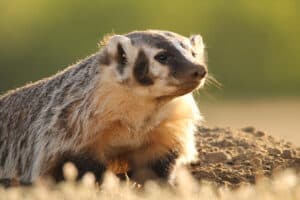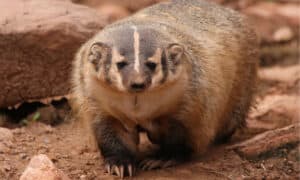If you’ve opened this article, you must’ve stumbled upon an animal’s poop around your house or while camping in the woods or open areas and are eager to know what animal came nearby. Was it a rat, a rabbit, or maybe a badger? Today we’ll tell you everything there is to know about badgers and their poop!
What are badgers?

Badgers are members of the
Mustelidaefamily.
©Warren Metcalf/Shutterstock.com
Badgers are scientifically named Taxidea Taxus and are members of the Mustelidae family. There are four subfamilies within the Mustelidae family:
- The Melinae Subfamily, which includes Eurasian badgers and Northern, Greater, and Sumatran hog badgers
- The Helictidinae Subfamily, which includes Burmese, Javan, Chinese, Formosan, Bornean, and Vietnam ferret-badgers
- The Mellivorinae Subfamily, called honey badgers
- The Taxideinae Subfamily, which includes American badgers and three extinct species
These four types of badgers include 18 species, out of which 3 are extinct.
People often find badgers to be appealing creatures due to their cute appearance. They have short, stubby legs, a short neck, a wide and flat head, and a tail. They are approximately 16-29 inches long and 9 inches high, while their tail measures 4 to 6 inches long. They weigh 9 to 26 pounds on average.
Badgers have an interesting coat color pattern. They are usually gray, but their faces are of a darker shade. They feature a white stripe running from their backs to their noses.
Badgers prefer living in burrows located in open habitats that can be found at lower elevations. However, the place they settle in highly depends on the badger’s gender, the season, and the prey living there. For example, badgers live underground during winter and spend the whole season fasting. However, badgers rarely stay in the same burrow for more than a few days during summer. They tend to move around often. They may return to some holes later if the prey is abundant.
Here are some places where you can find badgers:
- Grasslands;
- Open fields;
- Parks;
- Farms;
- Places with rodent supplies;
- Mountain meadows;
- Forest glades;
- Hot deserts;
- Brushy areas;
- Agricultural areas;
- Scrub areas;
- Other animals’ homes, such as gopher holes.
What do badgers eat?
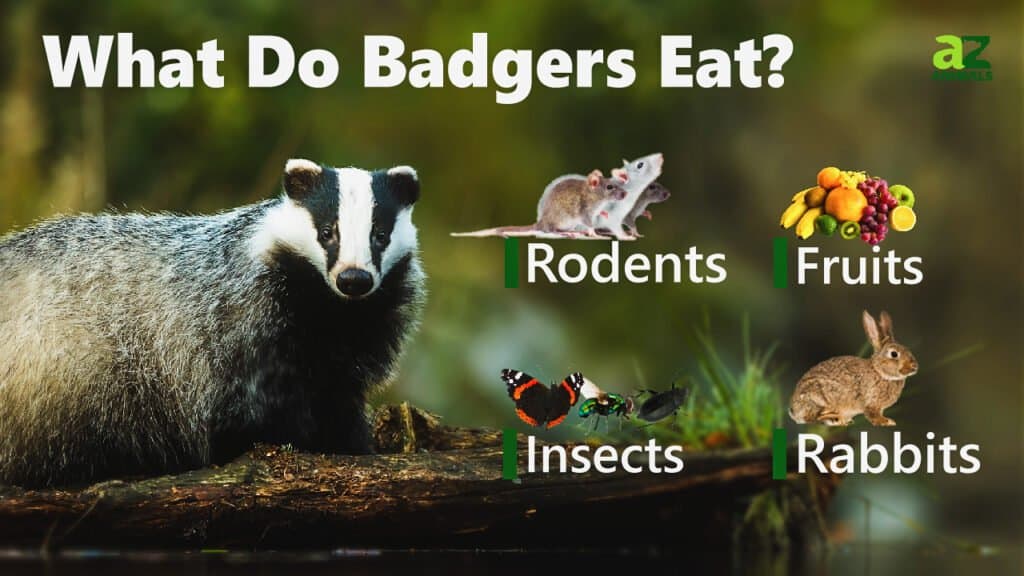
Badgers are omnivores. While their primary food source consists of rodents, they can eat many other things, even corn, and fruit. Here’s a list of what badgers eat:
- Mice
- Rats
- Rabbits
- Hedgehogs
- Scorpions
- Snakes (even rattlesnakes)
- Ground-nesting birds, such as the sand martin or the bank swallow
- Insects
- Slugs
- Grubs
- Earthworms
- Mushrooms
- Fruits
- Corn
A study on “Food Habits and Energy Utilization of Badgers” showed that ground squirrels, mice, and rabbits are among some of the primary food sources for badgers. The research also showed that badgers prefer rabbits during spring and summer, mice during spring and fall, and ground squirrels during summer. Badgers are believed to prefer birds and eggs during the breeding and nesting seasons and toads and grains during fall.
During the study, badgers ate insects all year round but in small quantities. Moreover, researchers discovered that ground squirrels represent a primary source of fall fat storage.
What does badger poop look like?
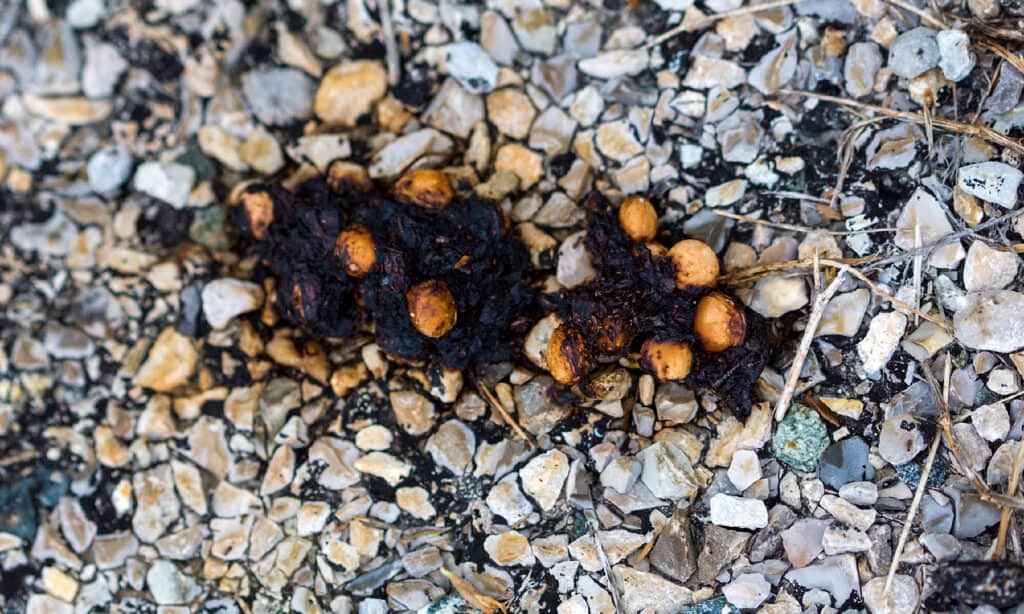
A badger’s diet determines the texture and form of its poop.
©iStock.com/Roel_Meijer
Badger poop appearance highly depends on what the animal eats. It is usually sloppy and wet. If you’ve found droppings around your house and you’re wondering whether they are from a badger, their smell may have the answer. Badger poop has a strong sweet smell.
The badger’s diet determines the texture and form of its poop. It can often be sausage-shaped. If a badger’s diet is rich in worms, its poo may be softer and darker. Poop size varies depending on how much the animal eats.
Is badger poop dangerous?
Like with any other animal feces, it’s advisable to take great care when removing or handling badger droppings, as they can contain numerous bacteria. Although the risk of getting a disease from a badger’s poop is similar to that of a dog or cat’s poop, you should not forget the basic hygienic procedures to avoid unpleasant consequences. It’s recommended to bury their droppings underground while wearing rubber gloves. Thoroughly wash your hands afterward!
Where do badgers poop?
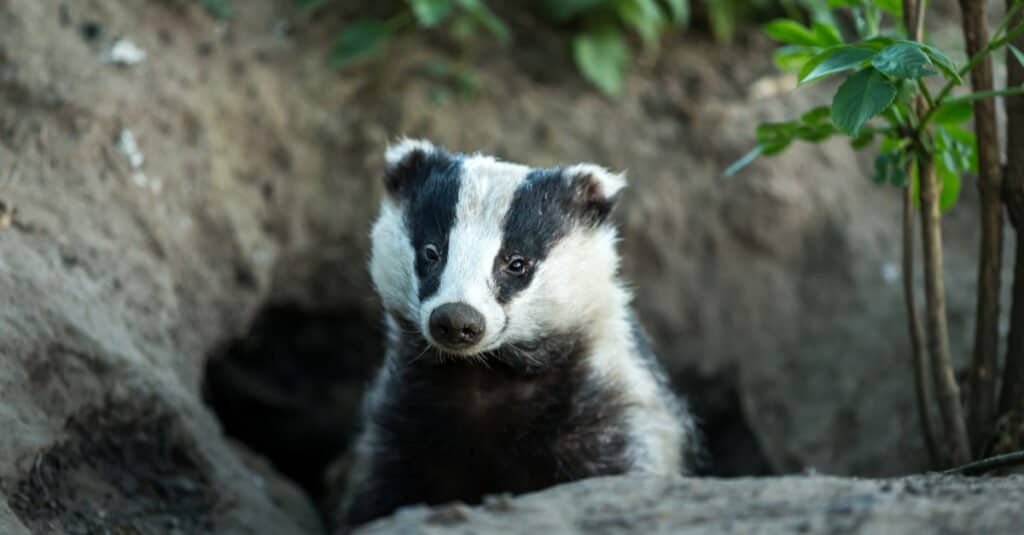
Badgers don’t defecate where they live. Instead, they usually build shallow pits at the periphery or outside of their territories.
©Coatesy/Shutterstock.com
Badgers have preferences in regards to where they defecate. They are considered very clean animals, as they won’t defecate where they live. They usually build shallow pits at the periphery or outside of their territories. These pits are used as “toilets.”
Badger poop vs. rabbit poop
Badger poop is usually sausage-like, while rabbit droppings consist of round, hard balls that are yellow, green, or brown.
Badger poop vs. otter poop
Otters poop along riverbanks, under bridges, or on rocks. Their poop can be dark green or black and may be full of fish bones. While badger poop has a sweet smell, otter poop has a fishy smell with a taint similar to that of jasmine tea. Otter droppings can be 1-3.9 inches long.
Badger poop vs. rat poop
Unlike badger poop, rat poop is oval-shaped. It is dark, rough, and thinner at either one or both ends.
Incredible badger facts
- It’s almost impossible to dislocate a badger’s jaw, which makes it an excellent predator!
- Badgers don’t actually hibernate during winter. They just sleep for long periods. They maintain their energy this way.
- The Bornean ferret-badger is an endangered species. It lives only in the northern region of the island of Borneo.
- Badgers are excellent diggers. Their homes sometimes consist of whole tunnels that are passed down from generation to generation! Some homes are more than 100 years old!
- You already know badgers are clean animals and have designated places for pooping. Here’s another secret! They change their bedding daily. Badgers sleep on leaves or grass and usually replace them daily with fresh ones.
- Badgers are resistant to snake venom! That’s probably the reason they sometimes feed on rattlesnakes!
- Badgers are social creatures. The American Badger, however, is not as sociable as other species and likes spending time alone.
- Badgers have a very sharp sense of smell! It is 800 times sharper than a human’s!
The photo featured at the top of this post is © Coatesy/Shutterstock.com
Thank you for reading! Have some feedback for us? Contact the AZ Animals editorial team.




